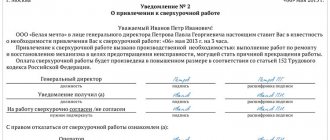Author of the article: Sudakov A.P.
An officially employed person is obliged to carry out the employer’s tasks provided for by the positions of the job description and the provisions of the employment contract. Implementation of functional responsibilities is carried out during working hours. Its duration must be agreed upon between the parties to the labor relationship before signing the cooperation agreement.
Work time
The boundary indicators of the parameter are provided for by the norms of legal acts, within the limits of which the employer has the right to establish his own criteria and approve them in the internal regulations of the enterprise. The standards must be reflected in the labor and collective agreement. Despite the apparent clarity of the topic, many employers have the question of how many hours a full working day is?
What are working hours
Working time is identified by the time frame within which a person is required to perform job duties within the list of tasks provided for by the regulated requirements of the law and internal documents of the enterprise.
There are also other periods of time that can be classified as working. In order to avoid misunderstandings between the parties to the employment agreement and troubles for the employer due to claims from the employee due to the unwillingness to work more than the time regulated by law, it is necessary to discuss all issues before concluding the employment agreement. It is necessary to include all positions on cooperation. The provisions of the agreement cannot fail to comply with legal requirements.
What does the concept mean?
Before agreeing to a part-time position, it is recommended to study the specifics of the design and application of civil and labor legislation in relation to the employee being hired. It is necessary to study what it means to work part-time, and what social guarantees a person retains with such a design option.
There are some nuances to working part-time. What it is is determined from the meaning of the term “rate”, which implies full employment and workload according to the schedule at the enterprise with full wages according to the staffing table.
What is part-time is determined according to the Labor Code of the Russian Federation. In particular, Article 93 of the Labor Code of the Russian Federation, registration for a part-time schedule occurs in agreement with the employee or on his initiative at the time of hiring, or in the order of transition to a light schedule after full-time work.
In other words, in order to understand the principle of employment at ½ rate, you need to understand how work is paid in this mode. Since the contract provides for half-time employment of a person, his earnings are calculated in the same amount. As established by the Labor Code of the Russian Federation, the number of hours a person works per week does not affect his right to leave, registration of an entry in the work book, or crediting of length of service.
Part-time work can be done not only in the form of ½ rate. Alternative solutions include switching to remote work (outsourcing) or working from home.
How is it different from a shortened day?
The half rate does not affect the formation of a mandatory social package from the employer and the state, however, when applying, it is important to clarify how exactly part-time employment is reflected in the documents. Sometimes an employer dictates new conditions regarding the workload of an employee, transferring the enterprise or individual positions to a shorter working day. In contrast, working at 0.5 rate is purely voluntary.
There are also differences in other evaluation parameters:
- Payment for part-time work is calculated based on 50% of the salary according to the staffing table, and may be lower than the minimum wage. With a shortened working day, payment below 1 minimum wage is unacceptable.
- A shortened schedule is expected only for specific categories of employees, and ½-time work is mandatory only in certain exceptional cases (for example, part-time work), or by mutual agreement.
- Irregular hours and overtime are unacceptable at 0.5 rates, which cannot be said about a shortened day.
Duration of the working day according to the Labor Code
Types of working time
The basic norms of the Labor Code of the Russian Federation establish regulations for the weekly volume of work. It is set at 40 hours. For each working day there are 8 hours, provided that the employer supports a five-day work week. In practice, it is difficult to implement time distribution from this perspective. The director of the company has the right to independently set the time parameter. It can reach 10 or 12 hours a day. In order not to violate legal norms, in such a situation it is necessary to adjust the number of working days per week. A person working 10 hours a day should have a four-day work week.
What is part-time work
Let's look at what the term underemployment means. Essentially, it means that the employee is working part-time. That is, the employee has his own workplace, there is a scope of work and job responsibilities, but at the same time he works less than required under the employment contract. If a 40-hour workweek is considered the standard, then it is said to be incomplete when an employee works 5–25 hours.
Attention:
Almost all over the world there is a tendency to switch to part-time work for one reason or another. At the same time, a part-time employee has the same rights and responsibilities as a full-time employee.
Reasons for limiting time may vary. On the one hand, the employee himself may desire restrictions in order to devote more time to family, education or personal life. If these are the reasons, then these are voluntary restrictions. If a company or enterprise simply does not need a full-time employee (that is, there is nothing to load him with for the standard 40 hours a week), then this is a forced situation. An employee who works part-time receives a lower salary compared to his full-time colleagues, but at the same time he retains all benefits.
Employment is divided by area and varies by region
Activity distribution
During the working day, each person has the right to claim an hour's lunch time. Work activity should be distributed evenly. Weekends must be taken into account. With a six-day work schedule, there is one day off, and with a five-day work schedule, two days off. Going to work on rest days is paid at an increased rate.
The employer’s requirement to comply with the regulated procedure approved by the internal documentation of the enterprise is legal.
Payroll calculation procedure
If the enterprise uses a salary calculation system, then the salary of a particular employee is calculated using the formula C = O * Chf / Chn, where O is the monthly salary, Chn is the number of working hours in a given month according to the norm, Chf is the number of hours actually worked.
First you need to determine the norm of working hours per month using the formula Chn = N * Dm / Dn – Chp, where Dm is the number of working days in a given month, Dn is the number of working days in a week, and N is the length of the working week in hours, which is determined by the working hours contract and is limited to 40 hours (Article 91 of the Labor Code of the Russian Federation), and for certain professions the working week can be shortened - for example, for teachers the working week lasts 36 hours.
Chp – the number of pre-holiday days in a given month, since the pre-holiday shift lasts an hour shorter. When calculating the number of emergency situations, you need to take into account holidays in the next billing month, for example, there are no public holidays in April, but the working day on April 30 will be shortened by an hour due to the upcoming May holidays.
Example 1 . The employee has a monthly salary of 20,000 rubles and a standard five-day working week; in February, the employee took half a shift (4 hours) at his own expense twice. In February there are 20 working days and one pre-holiday, which means that the number of working hours according to the norm is 40 * 20 / 5 – 1 = 159 hours. The number of hours actually worked is less than the norm by 2 * 4 = 8 hours. The salary is 20,000 * (159 – / 159 = 18,993.71 rubles.
The employee has a monthly salary of 20,000 rubles and a standard five-day working week; in February, the employee took half a shift (4 hours) at his own expense twice. In February there are 20 working days and one pre-holiday, which means that the number of working hours according to the norm is 40 * 20 / 5 – 1 = 159 hours. The number of hours actually worked is less than the norm by 2 * 4 = 8 hours. The salary is 20,000 * (159 – / 159 = 18,993.71 rubles.
Hourly payment
If a time-based tariff payment system is used, then to calculate wages by the hour, the formula C = Tch * H is used, where Tch is the tariff rate per hour of work in rubles, H is the number of hours worked in a given month. Time-based payment in its pure form is rarely used; in most cases, enterprises introduce bonuses, which are reduced for reducing the number of hours worked below the norm (for example, due to absenteeism) and increased during overtime.
It is important to note that the rate for overtime during the first two hours after the end of the shift must be at least 150% of the basic rate, and for overtime over 2 hours - at least 200% of the base rate for each hour of overtime starting from the third. The rate for work on weekends and holidays is also 200% of the basic hourly rate.
The rate for night shifts from 10 p.m. to 6 a.m. must be at least 120% of the standard rate, according to Government Resolution No. 554.
Example 2 . The tariff rate of a watchman working according to the railway schedule is 150 rubles per hour. In February, the employee was late after his shift 2 times - once for an hour, another time for 3 hours. The number of shifts for February is 14, of which 7 are night shifts. The night shift lasts from 20.00 to 8 am, including an hour break for lunch.
The number of daily working hours according to the norm : 7 * 11 + 7 * 4 = 77 + 28 = 105 hours (of which 28 hours are part of the night shifts, not included in the period from 22 to 6 am). Number of night working hours according to the norm: 7 * 7 = 49. Number of hours at the rate of 150% - 3 hours, at the rate of 200% - 1 hour.
The salary is:
150 * 105 + 150 * 49 * 120% + 150 * 3 * 150% + 150 * 1 * 200% = 15750 + 8820 + 675 + 300 = 25545 rubles.
It is necessary to take into account that the employer will withhold a tax of 13% from the final calculated monthly salary amount.
Limitation of working hours
What are working hours
If for objective reasons a person cannot work according to the approved schedule, then the employer can establish an individual daily routine for him. Valid reasons for initiating an event are:
- other work;
- education;
- caring for a sick relative;
- having a child;
- pregnancy.
If a person is unable to work full time, the employer can assign him a part-time or reduced version. There are certain categories of employees for whom the length of the working day according to the Labor Code can be changed. The head of the enterprise does not have the right to refuse to adjust their work schedule. It may provide for a reduction of time on legal grounds if:
- employee age under 18 years;
- the employee is disabled in the first two groups;
- a person works in working conditions that, according to the results of workplace certification, are classified as harmful and dangerous.
Academic use
What does full employment mean? This concept in the United States applies to students (often university students) who are fully occupied with their course of study each academic year, 12 academic hours (50 minutes each) per week or more. “Lab hours” are usually counted as a third or a half hour. International students in the United States must obtain full-time student status in order to obtain a student visa. Often students only pay for their 12 classes, no matter how much they took on top of that. Adult students (usually under age 22 or 23) can use their parents' health insurance (or other insurance) when they are enrolled full-time for three semesters a year. Only this status usually gives the right to be a member of various student organizations. In the United States, there is a Department of Labor program that is designed for students with this status and obliges the employer to pay the student worker at least 85% of the minimum wage.
We briefly looked at full-time employment: rationing, duration, academic use. Leave your comments or additions to the material.
Averages
Operating modes
Information about how many hours there are in a working week in Russia is necessary for objective calculation of remuneration for an employee. When making calculations, you should focus on the parameters of the production calendar. It takes into account days of absence from work during holidays and during the weekly rest period. The average number of working days in a month is 21 days. The indicator may be reduced if the current month includes holidays that are approved at the government level as weekends.
Alternative
So, you already know what full-time work means. However, there is an alternative concept, the name of which is part-time, or part-time, employment. What does it mean?
In this case, the employee also fulfills the duties assigned to him. However, he spends significantly less time on this than with full-time employment. As a rule, such workers work no more than twenty hours during the week.
Part-time or part-time employment can be voluntary or forced. In the first case, the employee himself seeks to reduce the number of working hours. In the second case, such a measure is considered forced, and its initiative comes from management. As a rule, the reason for this is the difficult economic situation of the enterprise, in which it is not possible to pay employees full salaries. For the latter, such a measure means a reduction in the level of wages and, accordingly, the standard of living.







